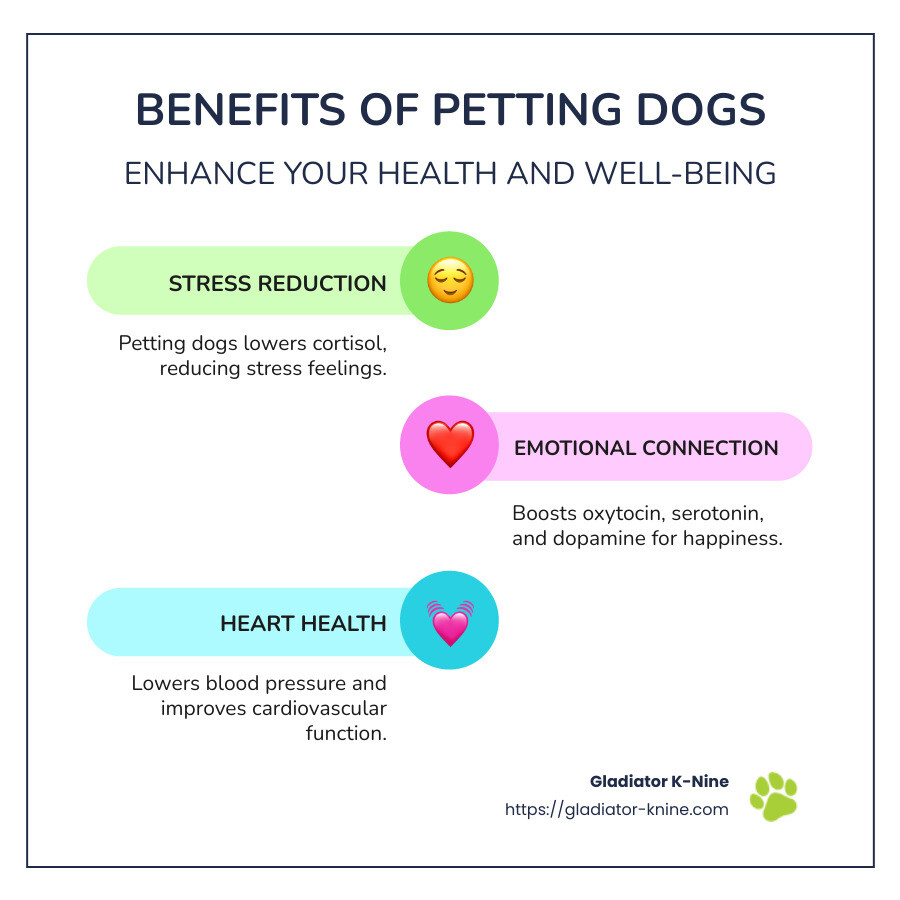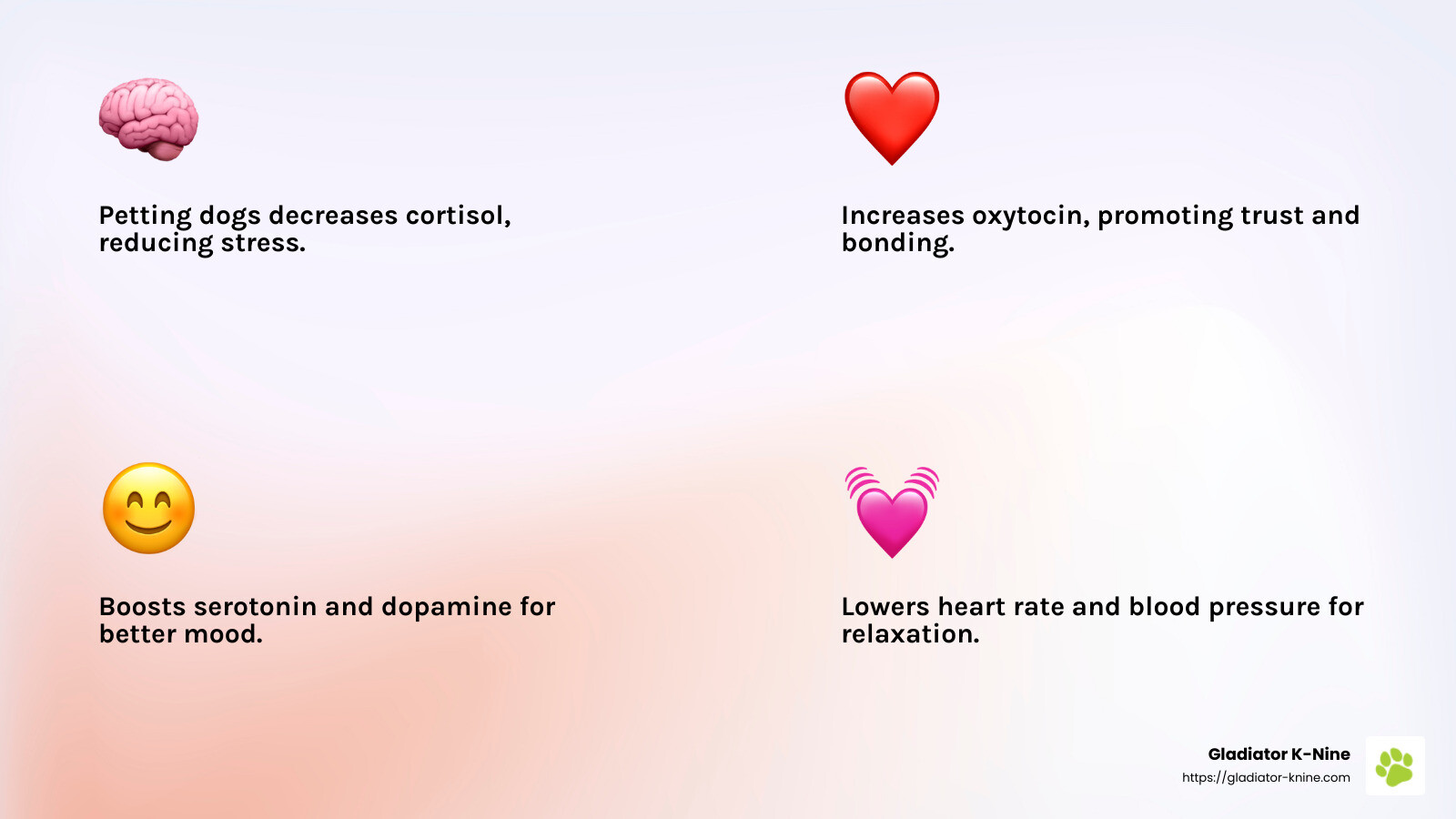December 3, 2024
Top 5 Amazing Health Benefits of Petting Your Dog
Petting Dogs for Stress Relief and Health Benefits
Petting dog stress relief is more than just a comforting phrase—it’s a proven aide in reducing stress and boosting overall well-being. Research consistently shows that spending time with a dog can do wonders for both mental and physical health. Here’s why:
- Reduces stress hormones: Petting dogs lowers cortisol levels, the hormone linked to stress.
- Increases happiness hormones: It boosts oxytocin, serotonin, and dopamine, which are associated with feelings of happiness and calm.
- Improves heart health: Lowers blood pressure and improves cardiovascular function.
- Improves mental health: Offers companionship that alleviates loneliness and depression.
Imagine coming home to a wagging tail that transforms a stressful day into a moment of joy. This simple act of petting can be a potent ally in achieving a healthier, happier life by nurturing deep connections that bolster both physical and mental health.
Pets, particularly dogs, offer a unique companionship that can ease life’s burdens. As psychology expert Rebecca Wallace notes, “The unconditional love from a pet can be an instant stress reliever.” If you are dealing with stress at work or want to boost your mental health, petting a dog could help. It might be the simple animal-assisted therapy you need.
The Science Behind Petting Dogs
Petting a dog is more than just a pleasant pastime—it’s a scientifically backed method to reduce stress. When you pet a dog, your body responds in remarkable ways. The act of petting lowers the stress hormone cortisol. Cortisol is the body’s alarm system, and too much of it can lead to chronic stress.
But there’s more. Petting a dog increases levels of oxytocin, often called the “love hormone.” This hormone is responsible for bonding and creates feelings of trust and relaxation. It’s the same hormone that helps bond mothers to their babies.
The benefits don’t stop there. Petting dogs also boosts serotonin and dopamine, neurotransmitters that play a key role in mood and happiness. Increased levels of these chemicals can lead to improved mood and reduced feelings of anxiety.
Physical Health Benefits of Animal-Assisted Therapy
The physical health benefits of petting dogs extend beyond just feeling good. As cortisol levels drop and oxytocin rises, your heart rate and blood pressure can also decrease. This leads to a more relaxed state.
Cardiovascular health is a major area where dogs make a positive impact. The American Heart Association endorses dog ownership as a way to ward off cardiovascular disease. Regular interactions with dogs can help maintain a healthy heart by keeping blood pressure in check and improving overall cardiovascular function.
Owning a dog often means increased physical activity. Whether it’s a brisk walk in the park or a playful fetch session, dogs encourage their owners to move. This not only helps with heart health but also contributes to overall physical fitness.
In summary, the simple act of petting a dog can lead to significant reductions in stress and improvements in both mental and physical health. It’s a natural therapy that comes with a wagging tail and a warm heart.
Emotional and Mental Health Benefits
Petting Dogs for Anxiety Relief
Petting dogs offers powerful benefits for emotional and mental health, especially when it comes to anxiety relief. Dogs provide a safe space where individuals can express their feelings without fear of judgment. This emotional support is crucial for those dealing with anxiety, as dogs offer a non-judgmental presence that can ease tension and create a sense of calm.
In moments of stress, petting a dog can lower anxiety levels by increasing the production of oxytocin and decreasing cortisol, the stress hormone. This hormonal shift helps individuals feel more relaxed and secure. Experts like Dr. Joey R. Gee emphasize the value of dog-assisted therapies, highlighting their effectiveness in calming environments, such as long-term care facilities and children.
Dogs also provide confidentiality. They serve as silent companions who listen without interrupting, allowing people to share their thoughts freely. This aspect of companionship can be particularly beneficial for those struggling with PTSD or depression, providing a comforting presence that aids in emotional healing.
Benefits for Children and Teens
Few emotional support animals are better than the dog. The impact of petting dogs extends to children and teens, offering essential benefits in stress management and emotional development. Pets can be a source of social support, helping kids build confidence and improve their social skills. Interacting with dogs can teach empathy and responsibility, which are crucial life skills.
For children experiencing loneliness or depression, a pet dog can be a constant friend and playmate. This companionship helps reduce feelings of isolation and promotes a sense of belonging. In educational settings, therapy dogs and emotional support animals have been shown to improve executive functioning. They specifically help students stay focused and calm during challenging tasks.
Moreover, dogs can assist in the emotional development of young people by providing a model of unconditional love and patience. By caring for a dog, children learn the importance of nurturing relationships and develop a deeper understanding of emotions—both their own and those of others.
In summary, petting dogs offers a simple yet effective way to reduce anxiety and improve emotional well-being for people of all ages. These furry friends provide unparalleled support, making them an invaluable part of a healthy lifestyle.
Practical Tips for Petting Dogs
Petting dogs is a simple act that brings significant benefits to both humans and dogs. However, to maximize these benefits, approach petting with some practical tips in mind.
Short Interactions, Emotional Support Animals, and Therapy Dogs
Short interactions with dogs can be incredibly effective in reducing stress. A few minutes of petting can lead to a noticeable decrease in stress levels, thanks to the increase in oxytocin and reduction in cortisol.
Therapy dogs, like those at Istanbul Airport, demonstrate this by providing comfort to stressed travelers with just a few moments of interaction. These dogs are trained to remain calm and approachable, making them ideal for therapeutic settings.
- Tags:
- Canine Anxiety





